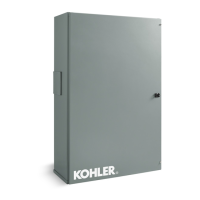TP-6745 7/1010 Section 1 Scheduled Maintenance
Short circuits. Hazardous voltage/current can cause
severe injury or death. Short circuits can cause bodily injury
and/or equipment damage . Do not contact electrical
connections with tools or jewelry while making adjustments or
repairs. Remove all jewelry before servicing the equipment.
Testing live electrical circuits. Hazardous voltage or
current can cause severe injury or death. Have trained and
qualified personnel take diagnostic measurements of live
circuits. Use adequately rated test equipment with electrically
insulated probes and follow the instructions of the test
equipment manufacturer when performing voltage tests.
Observe the following precautions when performing voltage
tests: (1) Remove all jewelry. (2) Stand on a dry, approved
electrically insulated mat. (3) Do not touch the enclosure or
components inside the enclosure. (4) Be prepared for the
system to operate automatically.
(600 volts and under)
Servicing the transfer switch. Hazardous voltage can
cause severe injury or death. Deenergize all power sources
before servicing. Turn off the main circuit breakers of all
transfer switch power sources and disable all generator sets
as follows: (1) Move all generator set master controller
switches to the OFF position. (2) Disconnect power to all
battery chargers. (3) Disconnect all battery cables, negative
(--) leads first. Reconnect negative (--) leads last when
reconnecting the battery cables after servicing. Follow these
precautions to prevent the starting of generator sets by an
automatic transfer switch, remote start/stop switch, or engine
start command from a remote computer. Before servicing any
components inside the enclosure: (1) Remove all jewelry. (2)
Stand on a dry, approved electrically insulated mat. (3) Test
circuits with a voltmeter to verify that they are deenergized.
Servicing the transfer switch controls and accessories
within the enclosure. Hazardous voltage can cause
severe injury or death. Disconnect the transfer switch
controls at the inline connector to deenergize the circuit
boards and logic circuitry but allow the transfer switch to
continue to supply power to the load. Disconnect all power
sources to accessories that are mounted within the enclosure
but are not wired through the controls and deenergized by
inline connector separation. Test circuits with a voltmeter to
verify that they are deenergized before servicing.
NOTICE
Hardware damage. The transfer switch may use both
American Standard and metric hardware. Use the correct size
tools to prevent rounding of the bolt heads and nuts.
NOTICE
Electrostatic discharge damage. Electrostatic discharge
(ESD) damages electronic circuit boards. Prevent
electrostatic discharge damage by wearing an approved
grounding wrist strap when handling electronic circuit boards
or integrated circuits. An approved grounding wrist strap
provides a high resistance (about 1 megohm), not a direct
short, to ground.
Screws and nuts are available in different hardness
ratings. To indicate hardness, American Standard
hardware uses a series of markings and metric
hardware uses a numeric system. Check the markings
on the bolt heads and nuts for identification.
1.2 General Inspection
External Inspection. Inspect the transfer switch
weekly.
D Look for any signs of vibration, leakage, excessive
noise, high temperature, contamination, or
deterioration.
D Remove accumulations of dirt, dust, and other
contaminants from the transfer switch’s exterior with
a vacuum cleaner or by wiping with a dry cloth or
brush. Do not use compressed air to clean the switch
because it can cause debris to lodge in the
components and damage the switch.
D Replace any worn, missing, or broken external
components with manufacturer-recommended
replacement parts. Contact a local authorized
distributor/dealer for part information and ordering.
D Tighten loose external hardware.
Contact an authorized distributor/dealer to inspect and
service the transfer switch when any wear, damage,
deterioration, or malfunction of the transfer switch or its
components is evident or suspected.
1.3 Internal Inspections and
Maintenance
1.3.1 Internal Inspection
Have an authorized distributor/ dealer perform an
annual inspection of the transfer switch. Inspect the
switch more frequently if it is located in a dusty or dirty
area or when any condition noticed during an external
inspection may have affected internal components.
Disconnect all power sources, open the transfer switch
enclosure, and inspect internal components. Look for:
D Accumulations of dirt, dust, moisture, or other
contaminants
D Signs of corrosion
D Worn, missing, or broken components
D Loose hardware
D Wire or cable insulation deterioration, cuts, or
abrasions
D Signs of overheating or loose connections:
discoloration of metal, melted plastic, or a burning
odor

